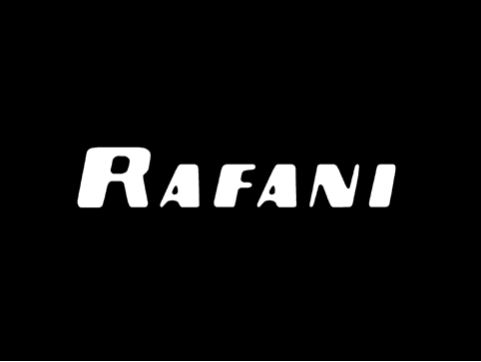

RAFANI is an artist-group operating mainly within the context of Czech Republic. It was founded in Prague in 2000 as an open, democratic and collective structure for artistic action within the society. Members come and go within the years, but a strong spirit of collective artistic responsibility in relationship to the society remains present. What impressed me most with RAFANIs ‘hardcore‘ group of young (angry) men – women are very welcome to join also – was their awareness of history combined with very actual artistic actions. Their relationship to historical events (recent as well as houndreds of years old) is serious but never didactic. They succeed in bringing the historical context into the present situation in a relevant and efficient way. Another interesting part of their work is that they accompany their actions with a public statement or a manifesto... This is a risky business in contemporary art and merits some attention in my opinion. Although RAFANI operates mainly within the Czech context I am convinced that their projects are relevant for a larger audience and can be understood within your own cultural and artistic background. Here is a choice of 5 projects that I find very interesting:
**********
LOVE – November 14th. 2000, John Lennon‘s Wall, Prague
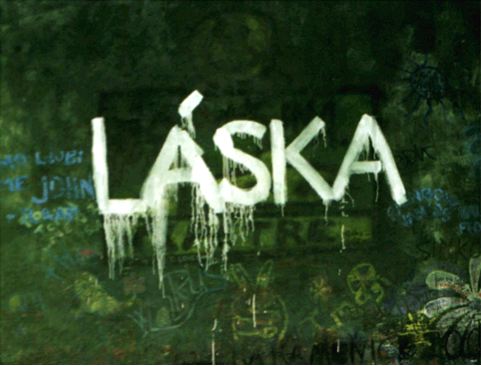
RAFANI painted the whole surface of the John Lennon‘s Wall with dark green colour, the same colour as the communist public police used to cover undesirable visual displays with. In the middle of the wall the expressively painted word ‘LOVE‘ was placed. The whole wall was signed by the RAFANI logo (a barking dog‘s head) in the lower right corner. The action was reported to – and finished with the presence of – the owner of the wall, the Order of Maltesian Knight‘s Representative as well as the Municipal Police of Prague.
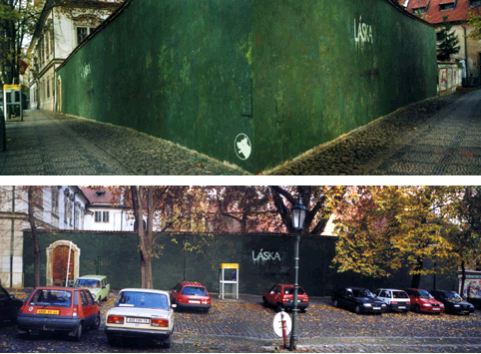
Text to the action:
The John Lennon‘s Wall used to have a meaningful and significant role in Prague. It was originally meant to be an honour to the killed representative of Hippies and a symbol for values like love, peace and tolerance. During the years of communist regime it became a symbol of defiance, freedom and of values of democracy. After the Velvet Revolution in 1989 political revolt started to disappear in favour of a certain kind of pseudo rebellion attitude which was corroding the values more and more. In 2000, when the Opposition Contract of our gouvernment was signed and in a time of general decline of values, RAFANI decided to realize the action LOVE. We painted the whole surface of the John Lennon‘s Wall with a dark green colour and in the middle we painted the word ‘LOVE‘. The whole wall was signed in the lower right corner with our logo as a piece of art. Our subversive action in the public space was meant to start a chain of relations and to contribute to the political evoluation of this monument. The colour itself was chosen to be identical to the colour that the communist public police used in order to fight against graffitis by Hippies and other dissidents. It is also associated to the ‘army green‘. These two associations contribute to an ambivalent relationship to the painted word ‘LOVE‘ and opens the discussion to embrace not only the values of contemporary society but also to reconsider the relationship between the Hippie Movement and society.
**********
IDENTIKIT – May 7th. 2001, Skolska 28 Gallery, Prague
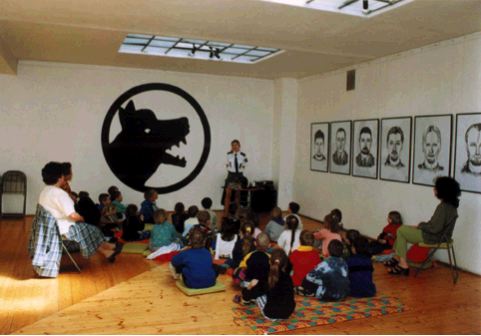
‘Identikit‘ is a picture of a face made from single segments based on a description. The Police uses this technique to create ghost-portraits of criminals and suspects. RAFANI collaborated with the local Police authorities in order to create Identikits of themself. The Police authorities created Identikits using the Facette technology. Each member of RAFANI made a visual description by memory of another member. According to the descriptions the Policeman offered different choices of parts of the face as drawings or photographs from a databank. The final Identikit is thus a collage made out of the choice that the police databank offered and of the visual memory of each member of RAFANI.
During the exhibition two lectures of the Publicity Department of the Czech Police were organized in the exhibition for local nursery schools.
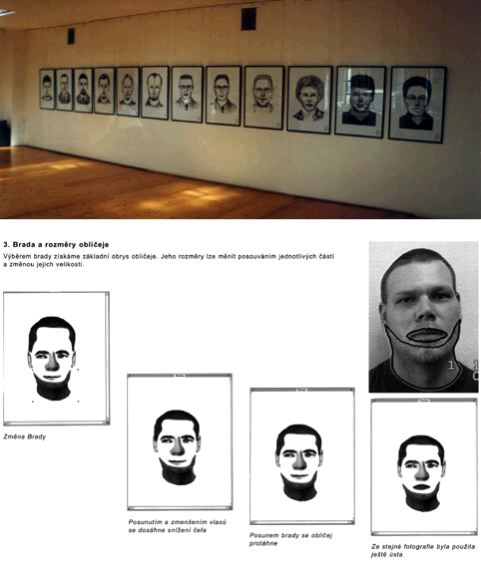
RAFANI also contributed with their digitalized faces for the extension of the Police Database recordings.
The exhibition was made out of the following elements: A block of 12 Identikits (70 x 100 cm), samples of the practical application of RAFANI memebers‘ eyes, mouths, ears etc. in the Police data Bank, the RAFANI logo painted on the wall, a publicity stand of the Czech Police Authorities as well as 2 lectures for small children organized in the show.
During the opening the Castle Guard Music Band dressed in ceremonial uniforms was playing and an official speech was held.
**********
FATHER – October 29th. 2001, Escort Gallery, Brno
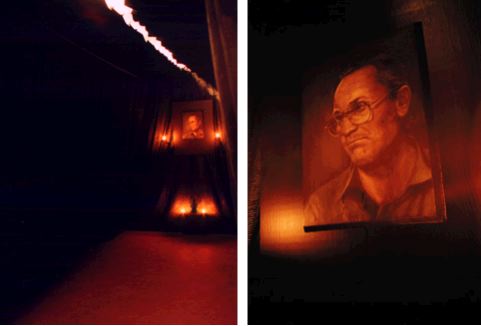
The central motive of the exhibition was a 4 meter long canopy tent made out of black velvet curtains. Inside it, in front of a black ‘altar‘ background hung an oil painting made on wood. It was the portrait of the father of Ales Martinu, a Czech skinhead who was killed in self-defence by a Czech artist, Pavel Opocensky, who tried to defend a woman that a group of skinheads attacked on the street. The painting connects with the tradition of ‘miraculous‘ religious paintings: it is crying and the teardrops are slowly falling into a glass bowl below it. A pious atmosphere was created by using candle light.
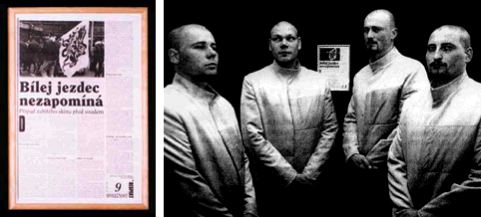
Instead of the opening speech one minute of pious silence was kept for the “victims of all ideologies“.
On the opposite side of the gallery there was another black velvet curtain with a framed article entitled “White Rider Never Forgets“, published in 1991 in a magazine called Respekt. The article was highlighted with a spotlight and it describes the event in the Myslikova Street, where a group of Skinheads verbally and physically attacked a woman passing by. A Czech sculptor, Pavel Opocensky, who had just returned to Czech Republic from a long stay abroad was incidentally present on that street. He wanted to help the woman and killed one of the Skinheads, Ales Martinu, in self-defence.
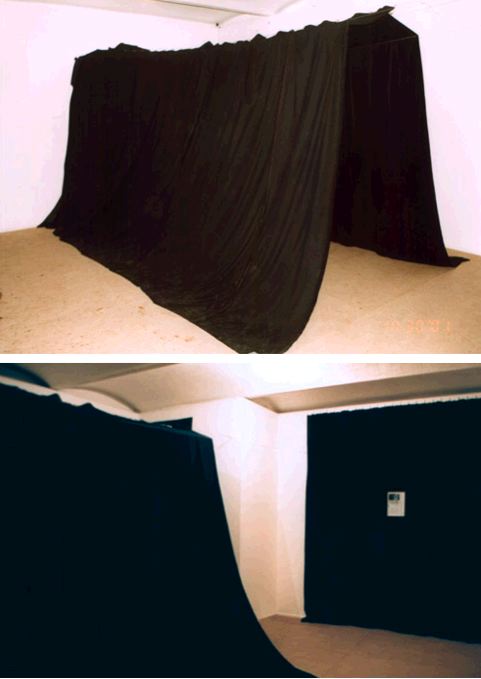
During the exhibition the lights of the exhibition space were switched off and the window was darkened.
**********
DEMOCRACY DEMONSTRATION – October 27th. 2002, Vaclavske namesti, Prague
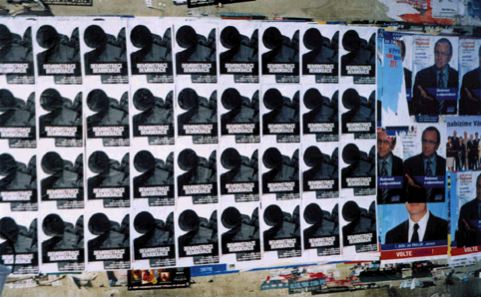
The action was announced officially to the Authorities of Prague in advance. The public was informed by a large poster campaign and by e-mail announcement.
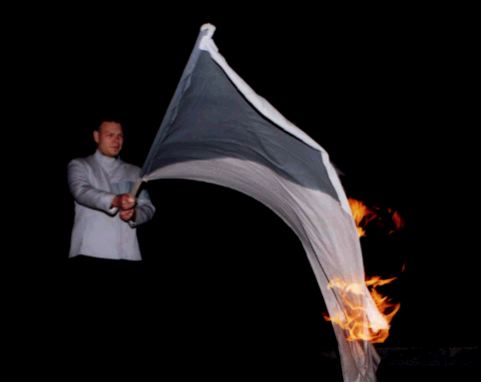
At 6 p.m. RAFANI arrived at the statue of St. Wenceslas on St. Wenceslas Square in the center of Prague. Dressed in grey-scale self-made uniforms they unveiled three grey-scale copies of the Czech national flag. Some minutes later one member suddenly put all the flags on fire using white spirit.
The action itself incorporated several aspects that were put into an antagonistic relationship and constituted the very subject of the ‘Democracy Demonstration‘.
The Flag as a symbol of the state and its grey-scale modification as an expression of values relating to this symbol. The act of its annihilation as an active (extremist) demonstration of opposite values of those demonstrated first by the modification of the official flag. The form of the actionitself was visually similar to actions of right-wing and left-wing extremism and was used in order to raise polemical questions about the limits of an acceptable or unacceptable manifestation.
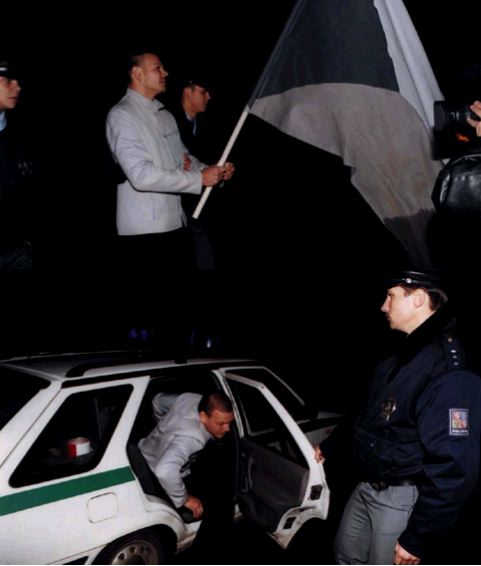
As soon as the flags caught fire the Policemen observating the demonstration reacted by taking the flags away and by arresting all the members of RAFANI. A press declaration about the action was released.
**********
BOHEMIAN FOREST – November 6th. 2002, Mala Spalovka Gallery, Prague
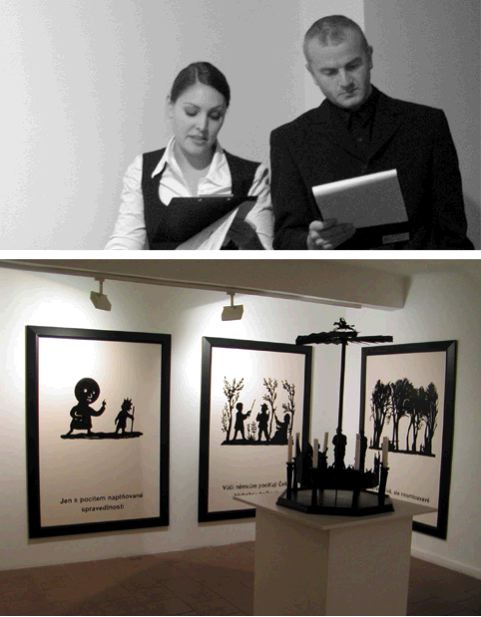
A work dealing with the displacement of ‘Sudeten Germans‘ after the World War II. Text of the opening: Bertolt Brecht, “Vom Tod im Wald“
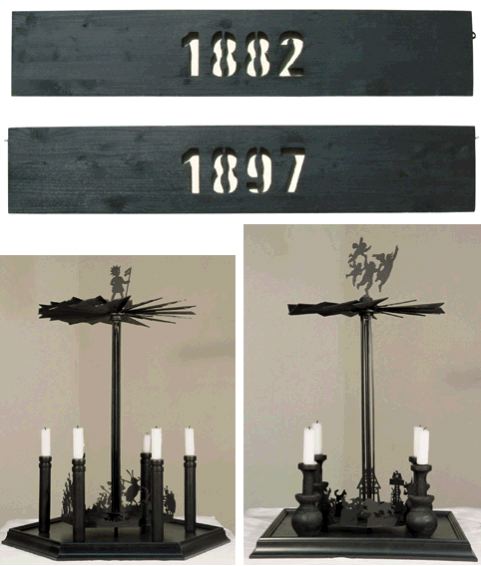
The original exhibition project was censored by the director of the Cultural Centre in Bilina. Another version of the project was realized later in the Mala Spalovka Gallery in Prague.
The elements used for the exhibition where:
Four yokes were installed in the corridor leading to the gallery. The dates carved out of the wood as well as their emplacement contributed to place the exhibition in its historical context.
Five merry-go-rounds, aesthetically inspired by typical folk-art from the Czech-German border area.
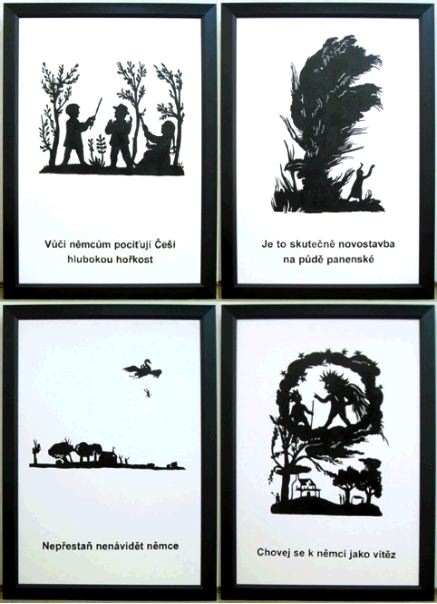
Ten paintings (170 x 150 cm). On the paintings details of typical Sudeten German silhouette clippings are shown in combination with chosen sentences from the Unofficial Decalogue of Czech Soldiers in the Borderland by presidents Benes and Fierlinger. A stake of fire-wood cut by metre was placed in one corner of the gallery.
**********
RAFANI in Berlin, january 2005
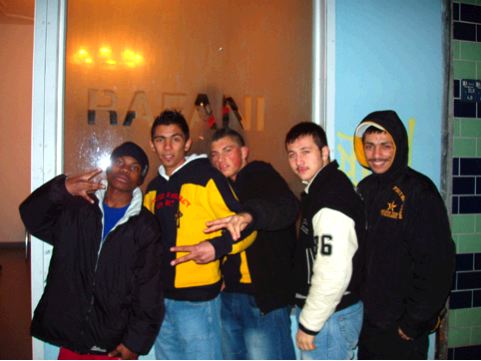
RAFANI executives are: Jiri Franta, Vaclav Magid, Marek Meduna, Petr Motejzik, Ludek Rathousky. For more information check out: www.rafani.cz – e-mail: rafani.us@seznam.cz
Documentation by Kristofer Paetau, march 2005
**********